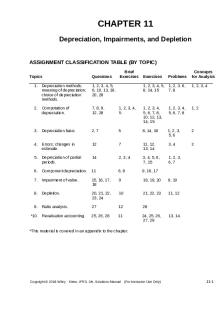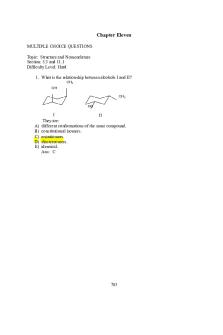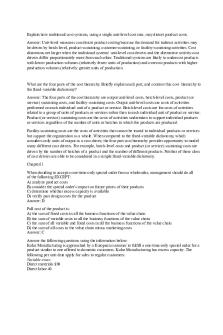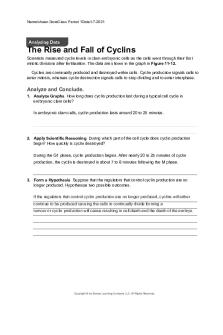Madura IFM10e IM Ch11 PDF

| Title | Madura IFM10e IM Ch11 |
|---|---|
| Author | Lamia H |
| Course | International Financial Management by J. Medura - 11th Edition |
| Institution | North South University |
| Pages | 25 |
| File Size | 498.4 KB |
| File Type | |
| Total Downloads | 72 |
| Total Views | 138 |
Summary
Download Madura IFM10e IM Ch11 PDF
Description
Answers to End of Chapter 11 Questions
1. He dgi ngi nGe ne r al .Expl a i nt her e l a t i ons hi pbe t we e nt hi sc ha pt e ronhe dgi nga ndt he
pr e vi ousc ha pt e ronme a s ur i nge xpos ur e . ANSWER: The previous chapter explains how to measure exposure, which is necessary before an MNC decides whether to hedge its exposure. 2. Money Market Hedge on Receivables. Assume that Stevens Point Co. has net receivables of 100,000 Singapore dollars in 90 days. The spot rate of the S$ is $.50, and the Singapore interest rate is 2% over 90 days. Suggest how the U.S. firm could implement a money market hedge. Be precise. ANSWER: The firm could borrow the amount of Singapore dollars so that the 100,000 Singapore dollars to be received could be used to pay off the loan. This amounts to (100,000/1.02) = about S$98,039, which could be converted to about $49,020 and invested. The borrowing of Singapore dollars has offset the transaction exposure due to the future receivables in Singapore dollars. 3. Money Market Hedge on Payables. Assume that Vermont Co. has net payables of 200,000 Mexican pesos in 180 days. The Mexican interest rate is 7% over 180 days, and the spot rate of the Mexican peso is $.10. Suggest how the U.S. firm could implement a money market hedge. Be precise. ANSWER: If the firm deposited MXP186,916 (computed as MXP200,000/1.07) into a Mexican bank earning 7% over 6 months, the deposit would be worth 200,000 pesos at the end of the six-month period. This amount would then be used to take care of the net payables. To make the initial deposit of 186,916 pesos, the firm would need about $18,692 (computed as 186,916 × $.10). It could borrow these funds. 4. Net Transaction Exposure. Why should an MNC identify net exposure before hedging? ANSWER: An MNC can reduce the amount of cash flow that it needs to hedge when identifying net exposure first. This can reduce the transaction costs associated with hedging. 5. Hedging with Futures. Explain how a U.S. corporation could hedge net receivables in euros with futures contracts. Explain how a U.S. corporation could hedge net payables in Japanese yen with futures contracts. ANSWER: The U.S. corporation could agree to a futures contract to sell euros at a specified date in the future and at a specified price. This locks in the exchange rate at which the euros could be sold. The U.S. corporation could purchase yen futures contracts that provide for yen to be received in exchange for dollars at a specified future date and at a specified price. The firm has locked in the rate at which it will exchange dollars for yen. 6. Hedging with Forward Contracts. Explain how a U.S. corporation could hedge net receivables in Malaysian ringgit with a forward contract. Explain how a U.S. corporation could hedge payables in Canadian dollars with a forward contract. ANSWER: The U.S. corporation could sell ringgit forward using a forward contract. This is accomplished by negotiating with a bank to provide the bank ringgit in exchange for dollars at a specified exchange rate (the forward rate) for a specified future date.
© 2010 Cengage Learning. All Rights Reserved. May not be copied, scanned, or duplicated, in whole or in part, except for use as permitted in a license distributed with a certain product or service or otherwise on a password-protected website for classroom use.
2 Managing Transaction Exposure The U.S. corporation could purchase Canadian dollars forward using a forward contract. This is accomplished by negotiating with a bank to provide the bank U.S. dollars in exchange for Canadian dollars at a specified exchange rate (the forward rate) for a specified future date. 7. Real Cost of Hedging Payables. Assume that Loras Corp. imported goods from New Zealand and needs 100,000 New Zealand dollars 180 days from now. It is trying to determine whether to hedge this position. Loras has developed the following probability distribution for the New Zealand dollar: Possible Value of New Zealand Dollar in 180 Days $.40 .45 .48 .50 .53 .55
Probability 5% 10% 30% 30% 20% 5%
The 180-day forward rate of the New Zealand dollar is $.52. The spot rate of the New Zealand dollar is $.49. Develop a table showing a feasibility analysis for hedging. That is, determine the possible differences between the costs of hedging versus no hedging. What is the probability that hedging will be more costly to the firm than not hedging? Determine the expected value of the additional cost of hedging. ANSWER: Amount of U.S. Dollars Needed to Possible Spot Rate Nominal Cost of Buy 100,000 NZ$ if of New Zealand Hedging 100,000 Firm Remains Real Cost of Dollar Probability NZ$ Unhedged Hedging $.40 5% $52,000 $40,000 $12,000 $.45 10% $52,000 $45,000 $7,000 $.48 30% $52,000 $48,000 $4,000 $.50 30% $52,000 $50,000 $2,000 $.53 20% $52,000 $53,000 -$1,000 $.55 5% $52,000 $55,000 -$3,000 ANSWER: There is a 75% probability that hedging will be more costly than no hedge. 5%($12,000) + 10%($7,000) + 30%($4,000) + 30%($2,000) + 20%(–$1,000) + 5%(–$3,000) =
$600 + $700 + $1200 + $600 – $200 – $150
=
$2,750
8. Benefits of Hedging. If hedging is expected to be more costly than not hedging, why would a firm even consider hedging? ANSWER: Firms often prefer knowing what their future cash flows will be as opposed to the uncertainty involved with an open position in a foreign currency. Thus, they may be willing to hedge even if they expect that the real cost of hedging will be positive.
© 2010 Cengage Learning. All Rights Reserved. May not be copied, scanned, or duplicated, in whole or in part, except for use as permitted in a license distributed with a certain product or service or otherwise on a password-protected website for classroom use.
Managing Transaction Exposure3 9. Real Cost of Hedging Payables. Assume that Suffolk Co. negotiated a forward contract to purchase 200,000 British pounds in 90 days. The 90-day forward rate was $1.40 per British pound. The pounds to be purchased were to be used to purchase British supplies. On the day the pounds were delivered in accordance with the forward contract, the spot rate of the British pound was $1.44. What was the real cost of hedging the payables for this U.S. firm? ANSWER: The U.S. dollars paid when hedging = $1.40(200,000) = $280,000. The dollars paid if unhedged = $1.44(200,000) = $288,000. The real cost of hedging payables = $280,000 – $288,000 = –$8,000. The U.S. dollars paid when hedging = $1.40(200,000) = $280,000. The dollars paid if unhedged = $1.34(200,000) = $268,000. The real cost of hedging payables = $280,000 – $268,000 = $12,000. 10. Hedging Decision. Kayla Co. imports products from Mexico, and it will make payment in pesos in 90 days. Interest rate parity holds. The prevailing interest rate in Mexico is very high, which reflects the high expected inflation there. Kayla expects that the Mexican peso will depreciate over the next 90 days. Yet, it plans to hedge its payables with a 90-day forward contract. Why may Kayla believe that it will pay a smaller amount of dollars when hedging than if it remains unhedged? ANSWER: Since Mexico presently has a very high interest rate, the forward rate of the peso would exhibit a discount according to interest rate parity. Kayla Co. may believe that today’s 90-day forward rate of the peso is lower than the expected spot rate in 90 days, which means that it will pay a smaller amount of dollar cash flows if it hedges than if it remains unhedged. 11. Forward versus Money Market Hedge on Payables. Assume the following information: 90-day U.S. interest rate = 4% 90-day Malaysian interest rate = 3% 90-day forward rate of Malaysian ringgit = $.400 Spot rate of Malaysian ringgit = $.404 Assume that the Santa Barbara Co. in the United States will need 300,000 ringgit in 90 days. It wishes to hedge this payables position. Would it be better off using a forward hedge or a money market hedge? Substantiate your answer with estimated costs for each type of hedge. ANSWER: If the firm uses the forward hedge, it will pay out 300,000($.400) = $120,000 in 90 days. If the firm uses a money market hedge, it will invest (300,000/1.03) = 291,262 ringgit now in a Malaysian deposit that will accumulate to 300,000 ringgit in 90 days. This implies that the number of U.S. dollars to be borrowed now is (291,262 × $.404) = $117,670. If this amount is borrowed today, Santa Barbara will need $122,377 to repay the loan in 90 days (computed as $117,670 × 1.04 = $122,377). In comparison, the firm will pay out $120,000 in 90 days if it uses the forward hedge and $122,377 if it uses the money market hedge. Thus, it should use the forward hedge. 12. Forward versus Money Market Hedge on Receivables. Assume the following information: 180-day U.S. interest rate = 8% 180-day British interest rate = 9% 180-day forward rate of British pound = $1.50 Spot rate of British pound = $1.48
© 2010 Cengage Learning. All Rights Reserved. May not be copied, scanned, or duplicated, in whole or in part, except for use as permitted in a license distributed with a certain product or service or otherwise on a password-protected website for classroom use.
4 Managing Transaction Exposure Assume that Riverside Corp. from the United States will receive 400,000 pounds in 180 days. Would it be better off using a forward hedge or a money market hedge? Substantiate your answer with estimated revenue for each type of hedge. ANSWER: If the firm uses a forward hedge, it will receive 400,000($1.50) = $600,000 in 180 days. If the firm uses a money market hedge, it will borrow (400,000/$1.09) = 366,972 pounds, to be converted to U.S. dollars and invested in the U.S. The 400,000 pounds received in 180 days will pay off this loan. The 366,972 pounds borrowed convert to about $543,119 (computed as 366,972 × $1.48), which when invested at 8% interest will accumulate to be worth about $586,569. In comparison, the firm will receive $600,000 in 180 days using the forward hedge, or about $586,569 in 180 days using the money market hedge. Thus, it should use the forward hedge. 13. Currency Options. Relate the use of currency options to hedging net payables and receivables. That is, when should currency puts be purchased, and when should currency calls be purchased? Why would Cleveland, Inc., consider hedging net payables or net receivables with currency options rather than forward contracts? What are the disadvantages of hedging with currency options as opposed to forward contracts? ANSWER: Currency call options should be purchased to hedge net payables. Currency put options should be purchased to hedge net receivables. Currency options not only provide a hedge, but they provide flexibility since they do not require a commitment to buy or sell a currency (whereas the forward contract does). A disadvantage of currency options is that a price (premium) is paid for the option itself. The only payment by a firm using a forward contract is the exchange of a currency as specified in the contract. 14. Currency Options. Can Brooklyn Co. determine whether currency options will be more or less expensive than a forward hedge when considering both hedging techniques to cover net payables in euros? Why or why not? ANSWER: No. The amount paid out when using a forward contract is known with certainty. However, the amount paid out when using currency options is not known until the period is over (since the firm has the flexibility to exercise the option only if it is feasible). Thus, the MNC cannot determine whether currency options will be more or less expensive than forward contracts when hedging net payables. 15. Long-term Hedging. How can a firm hedge long-term currency positions? Elaborate on each method. ANSWER: Long-term forward contracts are available to cover positions of five years or longer in some cases (for major currencies). Parallel loans can be used to exchange currencies and re-exchange the currencies at a specified future exchange rate and date. 16. Leading and Lagging. Under what conditions would Zona Co.’s subsidiary consider using a “leading” strategy to reduce transaction exposure? Under what conditions would Zona Co.’s subsidiary consider using a “lagging” strategy to reduce transaction exposure?
© 2010 Cengage Learning. All Rights Reserved. May not be copied, scanned, or duplicated, in whole or in part, except for use as permitted in a license distributed with a certain product or service or otherwise on a password-protected website for classroom use.
Managing Transaction Exposure5 ANSWER: If a subsidiary expected its currency to depreciate against an invoice currency on goods it imported, it may “lead” its payments (make payments early). If a subsidiary expected its currency to appreciate against an invoice currency on goods it imported, it may “lag” its payments (make a late payment). 17. Cross-Hedging. Explain how a firm can use cross-hedging to reduce transaction exposure. ANSWER: If a firm cannot hedge a specific currency, it can use a forward contract on a currency that is highly correlated with the currency of concern. 18. Currency Diversification. Explain how a firm can use currency diversification to reduce transaction exposure. ANSWER: If a firm has net inflows in a variety of currencies that are not highly correlated with each other, exposure is not as great as if the equivalent amount of funds were denominated in a single currency. This is because not all currencies will depreciate against the firm’s home currency simultaneously by the same degree. There may be a partial offsetting effect due to a diversified set of inflow currencies. If the firm has net outflows in a variety of currencies, the same argument would apply. 19. Hedging With Put Options. As treasurer of Tucson Corp. (a U.S. exporter to New Zealand), you must decide how to hedge (if at all) future receivables of 250,000 New Zealand dollars 90 days from now. Put options are available for a premium of $.03 per unit and an exercise price of $.49 per New Zealand dollar. The forecasted spot rate of the NZ$ in 90 days follows: Future Spot Rate $.44 .40 .38
Probability 30% 50 20
Given that you hedge your position with options, create a probability distribution for U.S. dollars to be received in 90 days. ANSWER: Possible Spot Rate $.44 $.40 $.38
Put Option Premium $.03 $.03 $.03
Exercise Option? Yes Yes Yes
Amount per Unit Received Accounting for Premium $.46 $.46 $.46
Total Amount Received for NZ$250,000 $115,000 $115,000 $115,000
Probability 30% 50% 20%
The probability distribution represents a 100% probability of receiving $115,000, based on the forecasts of the future spot rate of the NZ$. 20. Forward Hedge. Would Oregon Co.’s real cost of hedging Australian dollar payables every 90 days have been positive, negative, or about zero on average over a period in which the dollar weakened consistently? What does this imply about the forward rate as an unbiased predictor of the future spot rate? Explain.
© 2010 Cengage Learning. All Rights Reserved. May not be copied, scanned, or duplicated, in whole or in part, except for use as permitted in a license distributed with a certain product or service or otherwise on a password-protected website for classroom use.
6 Managing Transaction Exposure ANSWER: The nominal cost when hedging Australian dollar payables would have been below the nominal cost of payables on an unhedged basis during the weak dollar period, because the Australian dollar substantially appreciated during this period. Thus, the real cost of hedging would have been negative during the period. This implies that the Australian dollar’s forward rate consistently underestimated the Australian dollar’s future spot rate during the period and was therefore biased. 21. Implications of IRP for Hedging. If interest rate parity exists, would a forward hedge be more favorable, the same as, or less favorable than a money market hedge on euro payables? Explain. ANSWER: It would be equally favorable (assuming no transactions costs). If IRP exists, the forward premium on the forward rate would reflect the interest rate differential. The hedging of future payables with a forward purchase provides the same results as borrowing at the home interest rate and investing at the foreign interest rate to hedge euro payables. 22. Real Cost of Hedging. Would Montana Co.’s real cost of hedging Japanese yen receivables have been positive, negative, or about zero on average over a period in which the dollar weakened consistently? Explain. ANSWER: During the weak dollar period, the yen appreciated substantially against the dollar. Thus, the dollars received from hedging yen receivables would have been less than the dollars received if the yen receivables were not hedged. This implies that the real cost of hedging yen receivables would have been positive during the weak dollar period. 23. Forward versus Options Hedge on Payables. If you are a U.S. importer of Mexican goods and you believe that today’s forward rate of the peso is a very accurate estimate of the future spot rate, do you think Mexican peso call options would be a more appropriate hedge than the forward hedge? Explain. ANSWER: If the forward rate is close to or exceeds today’s spot rate, the forward hedge would be preferable because the call option hedge would require a premium to achieve about the same lockedin exchange rate. If the forward rate was much lower than today’s spot rate, the call option could be preferable because the firm could let the option expire and be better off. 24. Forward versus Options Hedge on Receivables You are an exporter of goods to the United Kingdom, and you believe that today’s forward rate of the British pound substantially underestimates the future spot rate. Company policy requires you to hedge your British pound receivables in some way. Would a forward hedge or a put option hedge be more appropriate? Explain. ANSWER: A put option would be preferable because it gives you the flexibility to exchange pounds for dollars at the prevailing spot rate when receiving payment. 25. Forward Hedging. Explain how a Malaysian firm can use the forward market to hedge periodic purchases of U.S. goods denominated in U.S. dollars. Explain how a French firm can use forward contracts to hedge periodic sales of goods sold to the United States that are invoiced in dollars. Explain how a British firm can use the forward market to hedge periodic purchases of Japanese goods denominated in yen. ANSWER: A Malaysian firm can purchase dollars forward with ringgit, which locks in the exchange rate at which it trades its ringgit for dollars. The French firm could purchase euros forward with dollars.
© 2010 Cengage Learning. All Rights Reserved. May not be copied, scanned, or duplicated, in whole or in part, except for use as permitted in a license distributed with a certain product or service or otherwise on a password-protected website for classroom use.
Managing Transaction Exposure7 The British firm can negotiate a forward contract with a bank to exchange pounds for yen at a future point in time. 26. Continuous Hedging. Cornell Co. purchases computer chips denominated in euros on a monthly basis from a Dutch supplier. To hedge its exchange rate risk, this U.S. firm negotiates a three-month forward contract three months before the next order will arrive. In other words, Cornell is always covered for the next three monthly shipments. Because Cornell consistently hedges in this manner, it is not concerned with exchange rate movements. Is Cornell insulated from exchange rate movements? Explain. ANSWER: No! Cornell is exposed to exchange rate risk over time because the forward rate changes over time. If the euro appreciates, the forward rate of the euro will likely rise over time, which increases the necessary payment by Cornell. 27. Hedging Payables with Currency Options. Malibu, Inc., is a U.S. company that imports British goods. It plans to use call options to hedge payables of 100,000 pounds in 90 days. Three call options are available that have an expiration date 90 days from now. Fill in the n...
Similar Free PDFs

Madura IFM10e IM Ch11
- 25 Pages

Ch11
- 28 Pages

0538482214 IFM10e TB 13
- 10 Pages

Ch11 - Solution manual ch11
- 83 Pages

Ch11 - kunjaw
- 95 Pages

Ch11 - dsdsdssssssssssssssssssssss
- 97 Pages

Allport La Personalidad Madura
- 4 Pages

Ch11 - nice
- 16 Pages

Ch11 - accounting
- 49 Pages

Review ch11
- 3 Pages

CH11 Outline
- 15 Pages

BIO CH11 Analyzing Data
- 1 Pages

Income Tax Banggawan Ch11
- 10 Pages

SM Ch11 - Answer Key
- 20 Pages
Popular Institutions
- Tinajero National High School - Annex
- Politeknik Caltex Riau
- Yokohama City University
- SGT University
- University of Al-Qadisiyah
- Divine Word College of Vigan
- Techniek College Rotterdam
- Universidade de Santiago
- Universiti Teknologi MARA Cawangan Johor Kampus Pasir Gudang
- Poltekkes Kemenkes Yogyakarta
- Baguio City National High School
- Colegio san marcos
- preparatoria uno
- Centro de Bachillerato Tecnológico Industrial y de Servicios No. 107
- Dalian Maritime University
- Quang Trung Secondary School
- Colegio Tecnológico en Informática
- Corporación Regional de Educación Superior
- Grupo CEDVA
- Dar Al Uloom University
- Centro de Estudios Preuniversitarios de la Universidad Nacional de Ingeniería
- 上智大学
- Aakash International School, Nuna Majara
- San Felipe Neri Catholic School
- Kang Chiao International School - New Taipei City
- Misamis Occidental National High School
- Institución Educativa Escuela Normal Juan Ladrilleros
- Kolehiyo ng Pantukan
- Batanes State College
- Instituto Continental
- Sekolah Menengah Kejuruan Kesehatan Kaltara (Tarakan)
- Colegio de La Inmaculada Concepcion - Cebu

